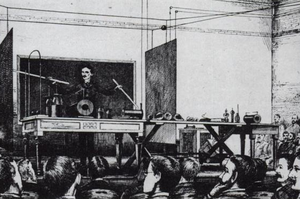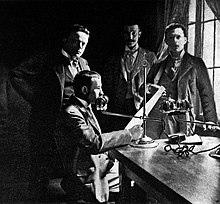Many physicists, inventors, engineers, developers, and businessmen contributed to produce modern radio systems. The origins and 'invention' are multiple and controversial. Early radio designs could not transmit sound or speech and were called the "wireless telegraph".
Development from a laboratory demonstration to a commercial entity spanned several decades and required the efforts of many practitioners. In 1878, David E. Hughes noticed that sparks could be heard in a telephone receiver when experimenting with his carbon microphone. He developed this carbon-based detector further and eventually could detect signals over a few hundred yards. He demonstrated his discovery to the Royal Society in 1880, but was told it was merely induction, and therefore abandoned further research.
In 1895, Guglielmo Marconi built a wireless system capable of transmitting signals at long distances (1.5 mi./ 2.4 km).[3][4] In radio transmission technology, early public experimenters had made short distance broadcasts.[5] Marconi achieved long range signalling due to a wireless transmitting apparatus and a radio receiver claimed by him.[6][7] From Marconi's experiments, the phenomenon that transmission range is proportional to the square of antenna height is known as "Marconi's law".[8] This formula represents a physical law that radio devices use. Marconi's experimental apparatus proved to be a complete, commercially successfulradio transmission system.[7][9][10] According to the Proceedings of the United States Naval Institute in 1899, the Marconi instruments had a "[...] coherer, principle of which was discovered some twenty years ago, [and was] the only electrical instrument or device contained in the apparatus that is at all new".[11]
In 1896, Marconi was awarded British patent 12039, Improvements in transmitting electrical impulses and signals and in apparatus there-for, for radio. In 1897, he established a radio station on the Isle of Wight, England. Marconi opened his "wireless" factory in Hall Street, Chelmsford, England in 1898, employing around 50 people. Shortly after the 1900s, Marconi held the patent rights for radio.
On Christmas Eve, 1906, Reginald Fessenden used a synchronous rotary-spark transmitter for the first AM radio program broadcast, from Ocean Bluff-Brant Rock, Massachusetts. Ships at sea heard a broadcast that included Fessenden playing O Holy Night on the violin and reading a passage from the Bible. This was, for all intents and purposes, the first transmission of what is now known as amplitude modulation or AM radio.


No comments:
Post a Comment